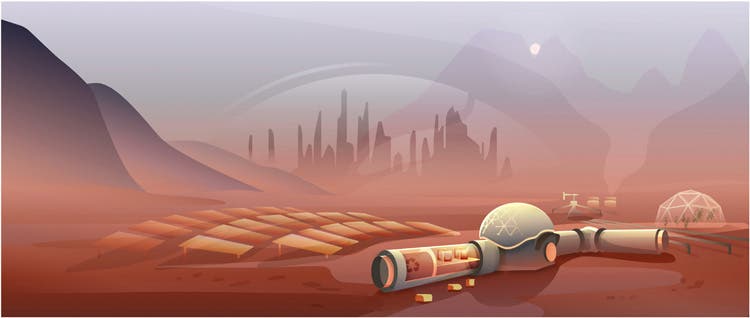Building a functional settlement on Mars that can safely harbor and meet the needs of a small group of people for extended periods of time is orders of magnitude more challenging than anything the space industry has undertaken thus far. One of the biggest challenges is how to power all the life support systems, scientific instruments, and food and fuel manufacturing facilities there. For a long time, the obvious choice seemed to be nuclear power, but a new study analyzed various power supply scenarios and found that solar panels are a better option, despite the unforgiving Martian environment.

If you want to keep a crew alive and well on Mars for more than a year, reliability is key. Nuclear power offers a stable source of energy 24/7, and modern reactors can be miniaturized specifically for such missions to fit inside a spacecraft. The fickle nature of solar power, with doesn’t run at night and is easily impeded by the ample red dust that covers the rusty surface of Mars, doesn’t make it very attractive.
But NASA does have experience with solar energy on Mars. The InSight lander currently operating on the Red Planet and tasked with studying Mars’ interior is run by solar panels, as were the twin Spirit and Opportunity rovers earlier this century. But the more recent Curiosity and Perseverance rovers run on plutonium, in a system called a Multi-Mission Radioisotope Thermoelectric Generator (MMRTG). However, the MMRTG isn’t a nuclear reactor, but rather a clever generator that converts the heat emitted by the plutonium decay into 110 watts of power, about the same as is used by an incandescent light bulb.
Despite the advantages of nuclear power, it is not immediately clear if it is the best option for an extended manned mission to Mars in light of the recent, phenomenal advances in solar energy. Solar panels have become highly efficient, lightweight, and flexible — just the right kind of characteristics you want to see in a space mission.
In a new study, researchers at Berkeley University made computer models that pitted a relatively small kilo-power nuclear system against a photovoltaic array with three power storage configurations: lithium-ion batteries for direct storage, and two different methods for generating hydrogen fuel from solar energy to be used later. Hydrogen could be made by splitting water molecules using excess electricity generated by the solar panels during the day and then ‘burned’ by fuel cells to power the settlement during the night, for example.

The power supply either method would need to produce was projected by estimating the energy requirements of biomanufacturing processes and other essential facilities that are critical to a six-person mission for 480 days. The main criterion was weight. A spacecraft ferrying crew and cargo to Mars could carry a payload of about 100 tons, not considering the mass of the fuel for a round trip, each way taking 210 days. A kilo-power nuclear reaction system has an estimated weight of 9.5 tons, while a solar panel array and accompanying hydrogen storage only weigh 8.3 tons.

This analysis found that for potential settlement sites over nearly half of Mars’ surface, solar is either comparable or superior to nuclear, in terms of weight and efficiency.
“Photovoltaic energy generation coupled to certain energy storage configurations in molecular hydrogen outperforms nuclear fusion reactors over 50% of the planet’s surface, mainly within those regions around the equatorial band, which is in fairly sharp contrast to what has been proposed over and over again in the literature, which is that it will be nuclear power,” said UC Berkeley bioengineering doctoral student Aaron Berliner.
The solar panels considered in this analysis aren’t your run-of-the-mill rooftop silicon panel, but rather state-of-the-art panels: highly efficient and very light. This means that you can pack quite a few backup solar panels that can be used in case some of the deployed panels malfunction. If the miniaturized nuclear power plant fails, this could spell disaster since backup options may be insufficient to meet all the settlement’s needs.
“This paper takes a global view of what power technologies are available and how we might deploy them, what are the best-use cases for them and where do they come up short,” said co-first author Anthony Abel, a graduate student in the Department of Chemical and Biomolecular Engineering. “If humanity collectively decides that we want to go to Mars, this kind of systems-level approach is necessary to accomplish it safely and minimize cost in a way that’s ethical. We want to have a clear-eyed comparison between options, whether we’re deciding which technologies to use, which locations to go to on Mars, how to go and whom to bring.”
The findings appeared in the journal Frontiers in Astronomy and Space Sciences.









